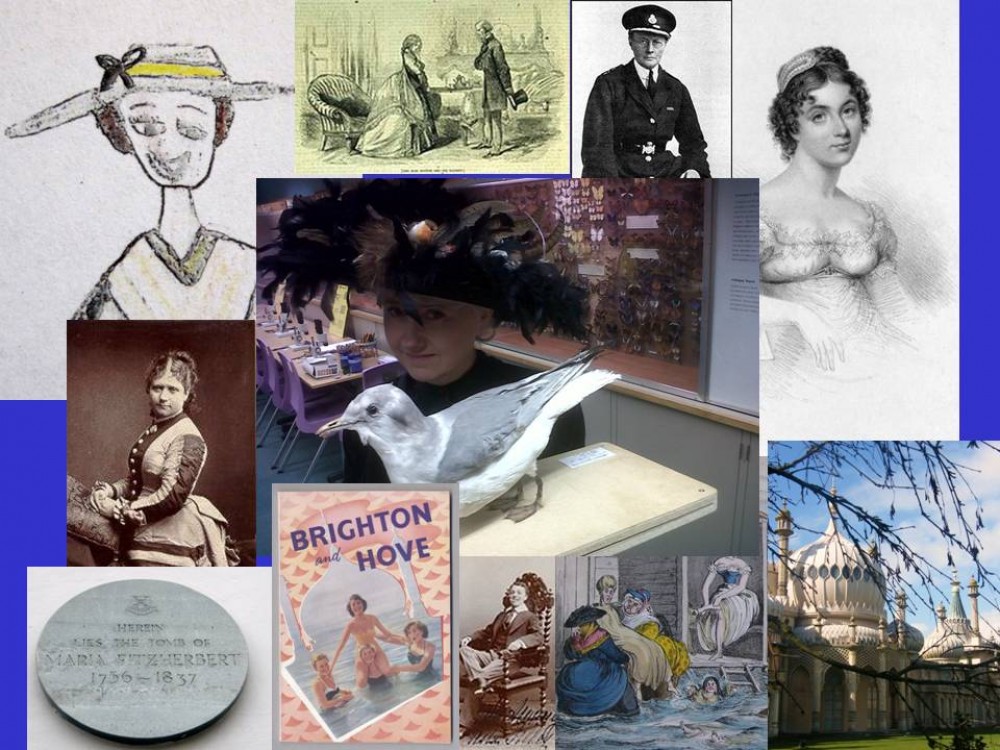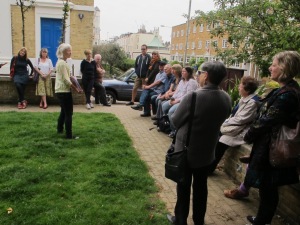
(Photo credit – Brighton and Sussex NHS Library and Knowledge Service) Yesterday I was invited to talk about the Pioneering Women Doctors of Brighton and Hove at the Royal Sussex Hospital. Incredibly moving for me, as the childhood home of Dr Sophia Jex-Blake, only the 3rd registered female doctor in Britain is in Sussex Square, only around 100 yards away from the very spot where I’m standing above. Sophia Jex-Blake, perhaps more than anyone else, opened doors for women to practise medicine. Following her turbulent time at the University of Edinburgh attempting to qualify as a doctor and eventually being refused her degree because she was a woman, she militated, agitated, wrote letters, argued, campaigned (getting Charles Darwin on her side in the process), whipped up publicity, and generally refused to let things lie until the 1876 Enabling Bill (brought by Russell Gurney, MP, then MP for Southampton), permitting medical institutions to license qualified people to become doctors regardless of their gender was passed.

This incredible woman was born in Hastings in 1840 – a blue plaque in the Old Town shows the place. The Jex-Blakes were a wealthy family and, as befitting of such in Victorian times, little attempt was made to provide an education to the womenfolk. Learning was considered by many to be harmful to a girl, leading to hysteria, infertility, and – worst of all – becoming ‘unmarriageable’. Unhappy with this situation and apparently not caring about any future husbands, the young Sophia managed, aged 18, to persuade her father to allow her to attend Queens College in London for a year, albeit with a chaperone.

Above: Sussex Square, Brighton. Sophia’s family lived at number 13 when she was eleven)
Much to the consternation and disbelief of Mr Jex-Blake, the young Sophia, after her year of education, decided she wanted to work as a Maths teacher. Her father just about bore this strange decision as long as Sophia agreed to work without a salary, seeing as being a paid worker wasn’t acceptable to one of their class. Interested in women’s education – or the lack of it – Sophia travelled to USA, far ahead of us in this respect, to visit schools. At a hospital in Boston she met pioneering American surgeon, Lucy Sewell, and there discovered her calling to be a doctor. In 1869 she applied to the University of Edinburgh to study medicine but was promptly refused on the grounds that the university couldn’t be expected to make the necessary adjustments to educate ‘in the interest of one lady’. These arrangements included organising separate lectures and facilities, the idea of men and women studying anatomy and looking at pictures of bodies together being beyond the pale. Showing the resourcefulness and get up and go that were to characterise the rest of her career, Sophia simply placed adverts in national newspapers to see if any other ladies wanted to join her then the university wouldn’t have this problem. Six women did, the university couldn’t back down and, in 1869, the ‘Edinburgh Seven’, the very first female students to study medicine – came into being.
… But the battle was far from being won. The women faced a hard prospect. Not everyone saw their presence as a great leap forward. Hostility came from both students and staff. These women would never work as doctors, so the thinking went, so why were they wasting everyone’s time? Surely, this was just a frivolous hobby. Besides, everyone knew that women didn’t have the stamina or intellectual rigour of men. Tempers frayed in 1870 when one of the women, Edith Pechey, who would go on to work in a women’s hospital in Mumbai, took first place in exams. Normally, this would qualify her for the Hope scholarship, which awarded the winner free use of the facilities of the chemistry labs. Thinking that this would be unpopular with the majority of male students, however, the university decided to hand the scholarship to a man who”d achieved lower scores. The Hope scholarship wrangle attracted a lot of publicity and the women found much public sympathy. But the challenges kept coming – doors were slammed in their faces, nameplates were vandalised, Sophia found a Catherine wheel attached to her door, filthy letters were sent, and Edith Pechey complained that male students had shouted ‘whore’ at her in the street.

On November 18th 1870 tensions boiled over even more. On the day of an important exam, the seven women turned up at the university’s Surgeon’s Hall (above), only to find their entrance barred by male students who pelted them with rubbish and shouted insults before slamming the door in their faces. This shocking event, the ‘Surgeon’s Hall Riot’, as it came to be known, was, again, widely publicised. This time, Charles Darwin publicly supported them. As a sign of the turning ide of public opinion, when Sophia wrote a letter to the press, naming and shaming members of staff she felt had incited the riot, and was consequently sued for libel by them, members of the public stumped up her almost £1000 fine.
Sadly, however, despite growing public support and the four years’ of hard work the women put in, the university decided at the last minute that it would be inappropriate to award degrees to the seven women, a decision supported by Court of Session of the Court of Scotland. Five of the seven had no option but to qualify abroad. Sophia went to Berne, Switzerland, in 1877, taking the same exams she’d already passed in Scotland but this time in German.
The coming of the Enabling Bill in 1876 was inspired by the actions of the Edinburgh Seven. Sophia had campaigned tirelessly for it to come into being.
Following a couple of years in London where she helped to set up the London School of Medicine for Women, Sophia returned to Edinburgh where she opened an outpatient clinic offering poor women free and subsidised treatment. In 1885 this became the Edinburgh Hospital and Dispensary for Women and Children. In 1887, she helped to set up the Edinburgh School of Medicine for Women, which operated until the University of Edinburgh started to admit women in 1892.
Retiring in 1899, Sophia Jex-Blake remembered her Sussex roots and came to live in Mark Cross, Rotherfield, with her partner, Dr Margaret Todd. She died in 1912 and is buried in St Denys Churchyard, Rotherfield. Dr Todd, a Scottish doctor, who was also a well known novelist, published Sophia Jex-Blake’s life story.

(Photo courtesy BBC) In July this year Edinburgh University decided to award the degrees to the Edinburgh Seven posthumously. Third from the left is third year medical student, Simran Piya, who, receiving Sophia’s degree, said “We are honoured to accept these degrees on behalf of our predecessors, who are an inspiration to us all.”
Dr Sophia Jex-Blake worked hard to smooth the way for future generations of women doctors and set the scene in Brighton and Hove as a place where, in the 1890s and 1900s, the pioneering Doctors Helen Boyle and Louisa Martindale, were going to come and create more medical history.







